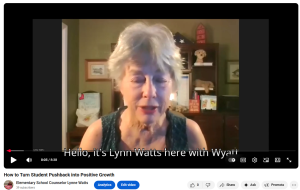“That’s Not Fair!” and Other Ploys: Turning Student Pushback Into Positive Growth
As elementary school counselors, we often encounter familiar phrases that students use as emotional shields, attempts to avoid accountability, or ways to test boundaries. These “ploys” may seem like resistance, but they’re actually great teaching moments. Here’s how to respond to five common student ploys with empathy, clarity, and growth-focused strategies.
- “It’s Not Fair.”
What They’re Really Saying:
“I feel hurt or left out,” or “I don’t like this outcome.”
Positive Response:
Empathize first: “It sounds like this feels really unfair to you.”
Then guide them toward perspective: “Fair doesn’t always mean equal. Let’s talk about why this decision was made.”
Picture Book Tie-In:
“The Recess Queen” by Alexis O’Neill
Mean Jean thinks she should control recess—until she learns what fairness and friendship really look like.
Why It Works: This book opens up conversations about fairness, inclusion, and learning to see beyond personal wants.
- “Everyone Else Gets To.”
What They’re Really Saying:
“I want to do this too, and I think if others can, I should be able to as well.”
Positive Response:
Acknowledge their desire: “It’s hard to feel like you’re missing out.”
Then offer a boundary: “In our class/school, we make choices based on what’s best and safest for everyone, not just what others are doing.”
Picture Book Tie-In:
“Lilly’s Purple Plastic Purse” by Kevin Henkes
Lilly struggles with envy and frustration when things don’t go her way.
Why It Works: The story highlights emotional regulation and accepting boundaries even when others seem to get more freedom.
- “What Else Could I Have Done?” (Said with sarcasm or defensiveness)
What They’re Really Saying:
“I don’t feel like I had any other choice” or “I’m trying to avoid blame.”
Positive Response:
Prompt reflective thinking: “That’s a great question! Let’s brainstorm a few ideas together.”
Shift the tone from sarcasm to strategy: “What’s one choice you could make next time that might work better?”
Picture Book Tie-In:
“What Should Danny Do?” by Ganit and Adir Levy
An interactive book that helps kids explore consequences through choice-making.
Why It Works: Reinforces the idea that there are always multiple options, even in tough situations.
- “You Don’t Like Me.”
What They’re Really Saying:
“I feel rejected, insecure, or misunderstood.”
Positive Response:
Reassure the relationship: “I care about you, even when I have to correct your behavior.”
Separate behavior from identity: “I didn’t like what you did, but that doesn’t change how I feel about you as a person.”
Picture Book Tie-In:
“Chrysanthemum” by Kevin Henkes
A story about self-worth and acceptance, especially when feeling different or rejected.
Why It Works: Opens up space for children to express their insecurities and feel safe being themselves.
- “You Did It Too.”
What They’re Really Saying:
“I don’t want to feel like I’m the only one who messes up.”
Positive Response:
Validate and redirect: “You’re right—everyone makes mistakes, even adults. The important thing is learning from them.”
Bring the focus back: “Let’s focus on what you can do now to make this better.”
Picture Book Tie-In:
“David Gets in Trouble” by David Shannon
David deflects blame, avoids responsibility, and eventually learns the power of a sincere apology.
Why It Works: Illustrates the common ploy of blaming others—and the value of taking responsibility.
Why These Ploys Matter
These common student phrases are windows into deeper needs—validation, safety, fairness, and belonging. When we respond with calm curiosity instead of frustration, we help children develop emotional intelligence and resilience. Picture books are powerful companions in this work, providing relatable stories that shift thinking and spark discussion.

